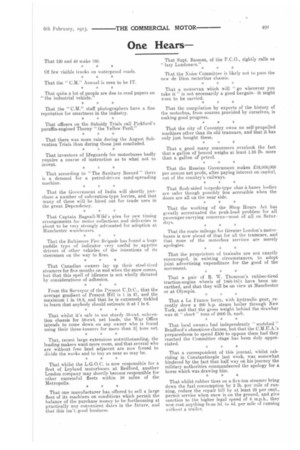One Hears
Page 3

If you've noticed an error in this article please click here to report it so we can fix it.
That 120 and 40 make 160.
Of few visible tracks on waterproof roads That the " C.M." Annual is seen to be IT.
That quite a lot of people are due to read papers on "the industrial vehicle."
That the " C.M-" staff photographers have a fine reputation for smartness in the industry.
That officers on the Subsidy Trials call Pickford's paraffin-engined Thorny "the Yellow Peril."
That there was more rain during the August Subvention Trials than during those just concluded.
That inventors of lifeguards for motorbuses badly require a course of instruction as to what not to invent.
That according to "The Sanitary Record" there is a demand for a petrol-driven sand-spreading machine.
That the Government of India will shortly purchase a number of subvention-type lorries, and that many of these will be hired out for trade uses in the great Dependency.
That Captain Bagnall-Wild's plea for new timing arrangements foe motor collections and deliveries is about to be very strongly advocated for adoption at Manchester warehouses.
That the Baltimore Fire Brigade has found a huge paddle type of indicator very useful to apprise•drivers of other vehicles of the intentions of its steersmen on the way to fires.
That Canadian owners lay up their steel-tired steamers for five months on end when the snow comes, but that this spell of idleness is not wholly dictated by considerations of adhesion.
Froth the Surveyor of the Prescot U.D.C., that the average gradient of Prescot Hill is 1 in. 21, and the maximum 1 in 18.2, and that he is extremely tickled to learn that anybody should estimate it at 1 in 6.
That whilst it's safe to use sturdy 30-cwt, subvention. chassis for 50-cwt. net loads, the War Office intends to come down on any owner who is found using their three-tormers for more than V,tons net.
That, recent large extensions notwithstanding, the leading makers want more room, and that several who are without free land adjacent are now forced to divide the works and to buy as near as may be.
That whilst the L.G.O.C. is now responsible for a fleet of Leyland motorbuses at Bedford, another London company may shortly become responsible for other successful fleets within 50 miles of the Metropolis.
That one manufacturer has offered to sell a large fleet of its machines on conditions which permit the balance of the purchase money to be forthcoming at practically any convenient dates in the future, and that this isn't good business. That Supt. Bassom, of the P.C.O., rightly calls us "lazy Londoners."
That the Noise Committee is likely not to pass the new de Dion motorbus chassis.
That a motorvan which will "go wherever you take it "is not necessarily a good bargain—it might want to be carried.
That the compilation by experts of the history of the motorbus, from sources provided by ourselves, is making good progress.
That the city of Coventry owns no self-propelled machines other than its old tramcars, and that it has only just bought these.
That a good many consumers overlook the fact that a gallon of benzol weighs at least 1.25 lb. more than a gallon of petrol.
That the Russian Government makes .216,000,000 per annum net profit, after paying interest on capital, out of the country's railways.
That flush-sided imrpedo-type char-h-bancs bodies are safer though possibly less accessible when the doors are all on the near side.
That the working of the Shop Hours Act has greatly accentuated the peak-load problem for all passenger-carrying concerns—most of all on Saturdays.
That the route mileage for Greater London's motorbuses is now ahead of that. for all the tramcars, and that none of the motorbus services are merely apologies.
That the proprietors of taxicabs are not exactly encouraged, in existing circumstances, to adopt joint advertising expenditure for the good of the movement.
That a pair of R. W. Thomson's rubber-tired traction-engine wheels of 1868-1874 have been unearthed. and that they will be on view at Manchester or at Olympia.
That a La. France lorry, with hydraulic gear, recently drew a 200 h.p. steam boiler through New York, and that the gross weight behind the drawbar was 46 " short" tons of 2000 lb. each.
That local owners had independently " scotched " Bradford's obnoxious clauses, but that the C.M.U.A.'s preparedness to spend £500 to oppose them had they reached the Committee stage has been duly appreciated.
That a correspondent of this journal, whilst cabriding in Constantinople last week, was somewhat hindered by the fact that half way on his journey the military authorities commandeered the apology for a horse which was drawing him.
That. whilst rubber tires on a five-ton steamer bring down the fuel consumption by 2 lb. per mile of running, reduce the repair bill by at least 25 per cent., permit service when snow is on the ground, and give sanction to the higher legal speed of 8 m.p.h., they now cost anything from ad. to 4d. per mile of running willwra a trailer.






























